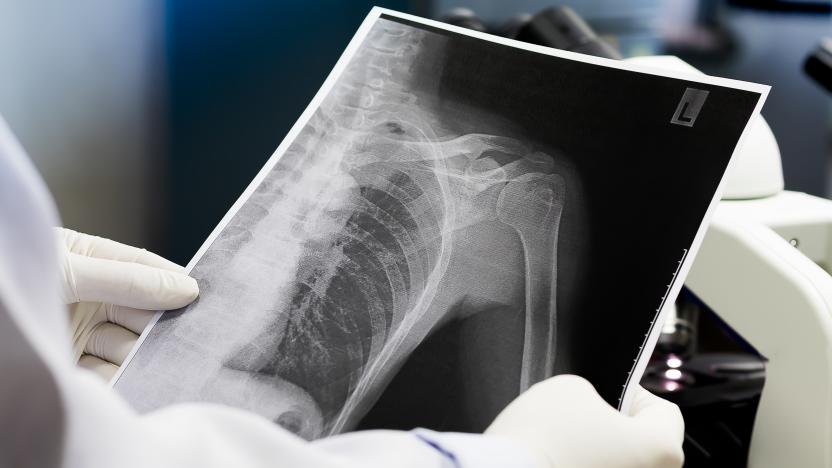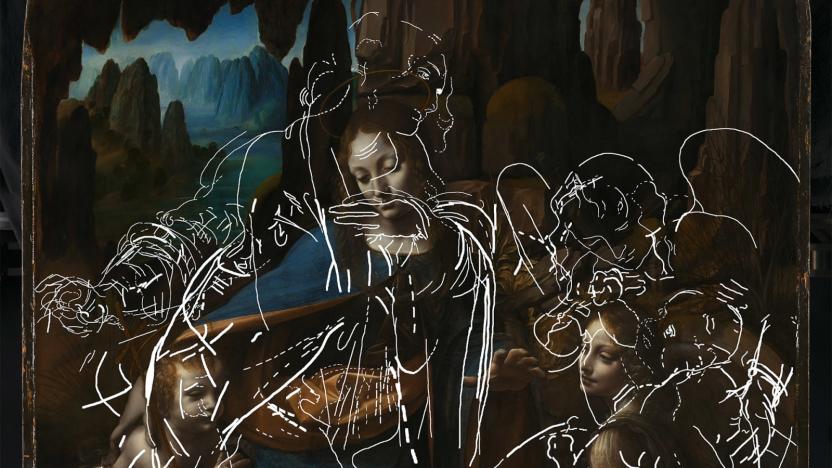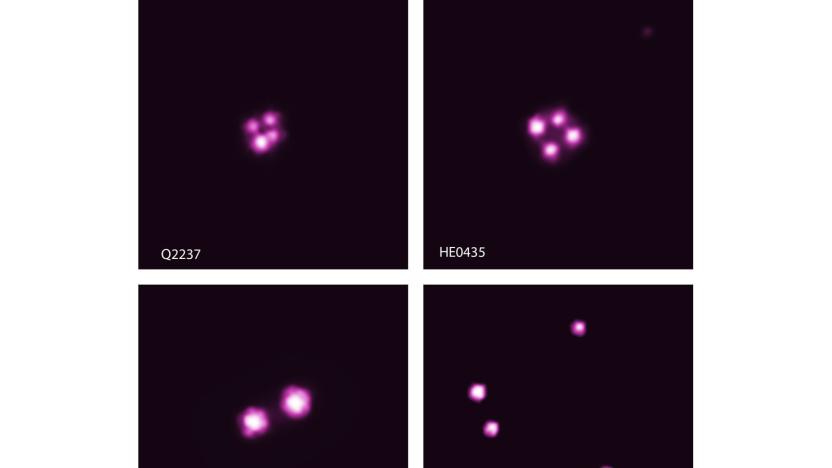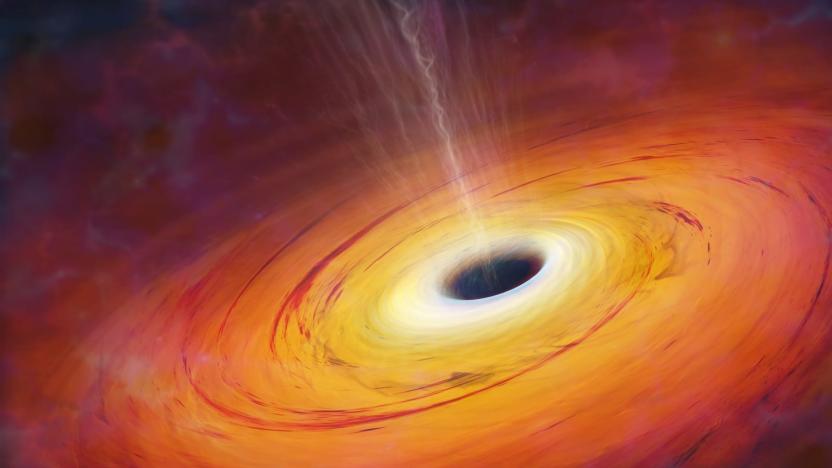x-rays
Latest

MIT AI system knows when to make a medical diagnosis or defer to an expert
MIT's machine learning system knows when to make a medical diagnosis and when to ask for human assistance.
Christine Fisher08.03.2020
A hidden da Vinci lurks beneath 'The Virgin of the Rocks'
Researchers at the National Gallery of London have used cutting-edge techniques to reveal a hidden drawing beneath Leonardo da Vinci's The Virgin of the Rocks. It shows that the great artist and his assistants, after laying out the original design, elected to take the biblical-themed painting in a completely different direction, to say the least.
Steve Dent09.03.2019
X-rays help astronomers detect spinning black holes
It can be tricky to measure the spin of a black hole, particularly when it's hard to see them, but astronomers have pulled off just such a feat. They've gauged the spins of five supermassive black holes through a combination of data from the Chandra X-ray Observatory and gravitational lensing, or the use of gravity from celestial bodies to magnify very distant objects.
Jon Fingas07.07.2019
Researchers identify red coloring in an ancient fossil for the first time
For the first time ever, researchers have detected chemical traces of red pigment in an ancient fossil. The discovery, which was published today in Nature Communications, was made using advanced X-ray imaging techniques applied to an exceptionally well-preserved fossil of a 3-million-year-old extinct species of field mouse. It presents a potential breakthrough that could help scientists better reconstruct animals that have long ceased to roam the earth and improve our understanding of evolution.
AJ Dellinger05.21.2019
NASA has a new plan to observe black holes with cosmic X-rays
Since humanity hasn't quite figured out a way to directly take a picture of black hole yet, NASA's next major science mission will send a trio of highly specialized telescopes into space to study the high-energy X-ray radiation surrounding black holes, neutron stars and pulsars. According to NASA's announcement today, the ultimate goal of the Imaging X-ray Polarimetry Explorer (IXPE) mission is to learn more about the gravitational, electric and magnetic fields at the edges of these cosmic phenomena.
Andrew Dalton01.04.2017
AI 'doctors' will diagnose your X-rays
An Israeli medical imaging company has signed a deal with a Utah-based healthcare provider that could change the way we diagnose certain conditions. Zebra Medical Imaging is teaming up with Intermountain to work on a neural network that will compare fresh X-rays with the "millions" stored in its own database. The eventual aim of the project is to offer up suggestions to radiographers and other medical professionals and eliminate costly misdiagnoses.
Daniel Cooper05.24.2016
Crazy fast X-ray laser catches chemical reactions in the act
Scientists at the Department of Energy's SLAC laboratory have taken a "molecular movie" of a chemical reaction for the first time. The results of their research could give new insights into to how chemical bonds form, helping researchers better understand biological processes. To give you an idea of the difficulty of the feat, the critical part of the reaction -- the breaking apart of a ring-shaped gas molecule -- takes a mere 200 femtoseconds (quadrillionths of a second). To record such a rapid process, the researchers used the two mile long Linac Coherent Light Source (LCLS) to fire X-ray laser pulses a mere 25 quadrillionths of a second in duration.
Steve Dent06.26.2015
Diamond hones DOE X-ray laser howitzer to razor-sharp precision
The US Department of Energy's SLAC accelerator lab already has a pretty useful X-ray laser -- the Linac Coherent Light Source (LCLS). But, recent modifications to the device have scientists drooling over its new found potential. Using a thin wafer of diamond, the Stanford-run lab filtered the beam to a lone frequency, then amplified it in a process called "self-seeding." That's given the world's most powerful X-ray laser even more punch by tossing out unneeded wavelengths which were reducing its intensity. The tweaks allow scientists across many fields to finesse and image matter at the atomic level, giving them more power to study and change it. According to the lab, researchers who came to observe the experiment from other X-ray laser facilities "were grinning from ear to ear" at the possibility of integrating the tech into their own labs. The SLAC team claims they could still add 10 times more punch to the LCLS with further optimization, putting the laser in a class by itself -- X-ray-wise, anyway.
Steve Dent08.12.2012
Panasonic preps SD cards that survive heat, water and X-rays, will probably outlast you
Much ado has been made of weather-resistant cameras, but it's all a moot point if the memory card dies, isn't it? Panasonic wants that level of survivability in its SDHC and SDXC cards, and its new UHS-I-level SDAB and SDUB lines are tested for the kind of abuse that could see the camera give up the ghost first. The cards can take the kinds of punishment that we often associate with rugged gear, such as temperatures from -13F to 185F, immersion in 3.3 feet of water for half an hour and the usual steep drops. It's beyond this that the resistance levels become truly exotic: the cards are also built to survive zaps of electricity, proximity to magnets and exposure to X-rays. If it all becomes too much to bear, the design will even fuse on the inside to prevent fire burning the card from within. Those who like what they see will only have to decide whether or not they want the SDAB range's 95MB/s read speeds and 80MB/s writes or are willing to settle for the SDUB line's respective 90MB/s and 45MB/s transfers. We have yet to see if or when the SD cards cross the Pacific after their September 8th launch in Japan, although we hope so -- with that kind of extra-tough design, our photos are more likely to endure than we will.
Jon Fingas08.09.2012
Researchers capture a single atom's shadow, has implications for quantum computers
A very small atom can cast a very large shadow. Well, not literally, but figuratively. Researchers at Griffith University have managed to snap the first image of a single atom's shadow and, while the dark spot may be physically small, the implications for the field of quantum computing are huge. The team of scientists blasted a Ytterbium atom suspended in air with a laser beam. Using a Fresnel lens, they were able to snap a photograph of the dark spot left in the atom's wake as the laser passed over it. The practical applications could improve the efficiency of quantum computers, where light is often used to transfer information. Since atoms have well understood light absorption properties, predictions can be made about the depth of a shadow cast, improving communication between the individual atoms performing calculations. The research could even be applied to seemingly mundane and established fields like X-Ray imaging, by enabling us to find the proper intensity levels to produce a quality image while minimizing damage to cells. For more info, check out the current issue of Nature.
Terrence O'Brien07.05.2012
NASA's NuSTAR probe snaps first X-ray image of feeding black hole
It was Bret Easton Ellis who coined the phrase, "The better you look, the more you see," and it appears the folks down at NASA's Jet Propulsion Lab agree. In what's considered a "first," the agency's latest space-scouring probe, the Nuclear Spectroscopic Telescope Array, has turned on its X-ray vision to capture focused images of a black hole, dubbed Cygnus X-1, feeding on a nearby giant star. By tuning into these high-energy frequencies, scientists are getting a peek into a previously unseen side of the heavens at 100 times the sensitivity and 10 times the resolution of any preceding tech. The space agency plans to use the observatory's powerful sight to suss out other known areas of mass X-ray activity like 3C273, an active quasar located two billion light years away and even explore G21.5-0.9, the fallout from a supernova within the Milky Way galaxy. NuSTAR's first tour of galactic duty will span two year's time, during which it'll attempt to record imagery from "the most energetic objects in the universe, " as well as track the existence of black holes throughout the cosmos. Impressed? Yeah, us too.
Joseph Volpe06.30.2012
New periodic table element names confirmed, textbook makers sigh in relief
What's in a name? If you're the general assembly of the International Union of Pure and Applied Physics, then quite a lot. It's that bunch who have finally rubber-stamped the names of elements Darmstadtium (110), Roentgenium (111) and Copernicum (112) on the Periodic table. The trio are so named in honor of Darmstadt (where it was first created), Wilhelm Röntgen (discoverer of X-Rays) and Nicolaus Copernicus (explaining the universe since 1533). All three elements are "super-heavy", lab-created substances that rapidly degrade down into less interesting materials -- Copernicium-285 has a relatively long half-life of 29 seconds. The ratification went without a hitch, causing a sigh of relief amongst the textbook makers who have included the elements in the table for quite some time. Although we were hoping that element 111 would have to change its name back to the original, nearly unpronounceable unununium. [Image courtesy of the BBC / Talkback Thames]
Daniel Cooper11.08.2011
Dutch researchers dust off X-ray machine from 1896 to compare it to modern equipment
This one is a bit shocking to us. X-rays were discovered in 1896, and recently, a team of researchers at Maastricht University Medical Center in the Netherlands pulled a machine from 1896 off the shelf for the purpose of comparing its results to modern equipment. The researchers say that this original equipment pumped out around 1,500 times more radiation than new equipment in order to produce its results. Speaking of those results, they are unsurprisingly less sharp and detailed than modern X-rays, but they still look pretty impressive if you ask us. The X-rays were conducted on a cadaver this time around rather than a living person because of the high levels of radiation. Full results will be published in the Journal Radiology this month.
Laura June Dziuban03.17.2011
Scotch tape surprises everyone by producing X-rays
As far as we're concerned, sticky tape is mostly just for out-there modding projects, but scientists have confirmed another use for it: X-rays. After hearing word of research in that direction by Soviet scientists in the 1950s, researchers at UCLA peeled scotch tape at 1.18 inches per second in a vacuum chamber and found that X-ray pulses were emitted by the process. A human thumb has already been successfully X-rayed by this technique, and if future investigation proceeds swimmingly, paramedics and aid workers operating off the grid might be able to do X-rays without bulky and dangerous nuclear technologies. We'll admit it -- we never saw scotch tape X-rays coming, but then, neither did you, right?[Via Switched]
Samuel Axon10.23.2008